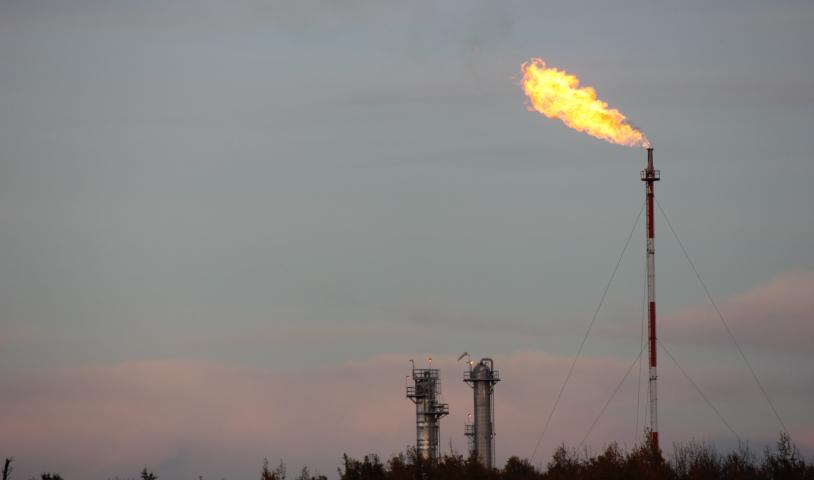Oil spill shows dangers of pipelines crossing waterways
Saturday, June 9, 2012
The spill is believed to have sent up to 475,000 litres of crude oil flowing into a rain-swollen Red Deer River system
The Wilderness Committee says a pipeline spill near Red Deer, Alberta demonstrates the hazards that pipelines pose.
The committee's Ben West says British Columbians have to be aware of these spills, as we contemplate two major pipeline projects.
"As Enbridge and others try to convince us that pipelines are safe, it's a lot hard for them to make that argument, as oil is spilling into waterways in Alberta as we speak."
Enbridge is proposing to build a pipeline through northern BC while Kinder Morgan wants to twin a pipeline that runs through the interior of the province.
"I think it's something like thousands of streams and rivers that the Enbridge pipeline would cross, many of them being salmon bearing," West notes.
Plains Midstream, the company that owns the pipeline near Red Deer, has no pipelines in this province.
Meanwhile, crews were scrambling Friday to clean up the spill that is believed to have sent up to 475,000 litres of crude oil flowing into a rain-swollen Red Deer River system in west-central Alberta.
Plains Midstream Canada says when the spill was discovered Thursday night it closed off its network of pipelines in the area.
Tracey McCrimmon, executive director of a community group that works with the industry, says it was rural homeowners who first raised the alarm about an oil pipeline spill.
She said people who live just north of Sundre phoned in reports Thursday night of smelling rotten eggs, the telltale odour of sour gas or sour oil.
"The first call that we got was at 8:40 p.m. There was an odour complaint. We had multiple calls of a rotten egg smell,'' said McCrimmon, director of the Sundre Petroleum Operators Group.
"We called all of the oil and gas operators within six kilometres of the area. They were able to source the odour within an hour.''
The company said the oil spilled into Jackson Creek near the community of Sundre, about 100 kilometres from Red Deer. Jackson Creek flows into the Red Deer River.
Recent heavy rains have swollen streams and rivers in the area, some to near flood stage, and local officials are concerned the oil will spread more quickly down the system.
"There's oil in the river and the river is moving very quickly right now because of the recent rains and meltwater,'' said Bruce Beattie, reeve of Mountain View County, which is on the river system.
"Certainly anything that is coming out of the pipeline or that did come out of the pipeline is certainly moving quickly down stream. It's going to be a major environmental concern for sure.''
The region around Sundre is considered pristine wilderness by many in Alberta. It is a common getaway area for people in Calgary and popular with anglers and hunters.
The area were the oil spilled is sparsely populated and mostly ranchland.
There was no immediate word from the Alberta government on whether the spill will threaten the quality of drinking water downstream. The community of Sundre is upriver from the spill, but Red Deer is downstream.
Crews are hoping to contain oil at a dam upstream from Red Deer.
The City of Red Deer has been told booms will be set up on the river near the Dickson dam and Gleniffer reservoir.
Leslie Chivers, a city spokesman, said people in Red Deer have been told there is nothing to worry about.
"I hesitate to use the word concern. Because if they can clean up the spill, then life is normal,'' Chivers said. "We are monitoring the situation at this time. And if things change, then we'll advise residents of further actions that will be happening.''
Plains Midstream said it was light sour crude that spilled. It said Alberta energy regulators and government health and environment officials are monitoring water and air quality in the area.
"Light sour crude oil has a strong petroleum odour but this odour does not pose a health or safety risk to the public,'' the company said in a news release.
Company vice president Stephen Bart expressed regret.
"We deeply regret this incident and are working to ensure we're doing all we can to limit the extent of the release and any community and environmental impacts,'' he said in a statement. "We're committing the resources necessary to mount a full-scale response.''
Staff at the Gleniffer Lake Resort on the shores of the reservoir said the company told them to stop using water from the lake and was hauling fresh water in for them.
Otherwise, they said they hadn't noticed the spill.
The spill comes as Plains Midstream continues to clean up an April 29, 2011 pipeline spill of 4.5 million litres of oil northeast of Peace River, Alta.
That leak, one of the largest in Alberta history, happened in a remote area on the 772 kilometre, 44-year-old Rainbow line between Zama, Alta. and Edmonton.
Early estimates suggested that spill was only several hundred barrels of oil. It wasn't until four days later that the energy board reported the full extent of the leak from a centimetre-wide crack around the bottom of the pipe.
Witnesses who flew over the site reported that oil was running into muskeg covering an area the size of two football fields. The black outline of the oil was clearly visible around the edge of the water, which was bordered on one side by a beaver pond credited with preventing the spill from being worse.
A school in the nearby First Nations community of Little Buffalo was closed for days after people reported getting headaches, feeling nauseous and smelling a strong petroleum odour. But both the company and the government said all air-quality readings remained within acceptable limits.
The break on the rainbow line is believed to have stemmed from maintenance done in 2010, when soil was packed in a way that led the pipe to settle and eventually crack.
Alberta's Energy Resources Conservation Board estimates there are about 400,000 kilometres of energy-related pipelines criss-crossing Alberta.
The conservation board is responsible for regulating pipelines that begin and end in Alberta. Pipelines that cross provincial boundaries or the U.S. border are regulated by the federal National Energy Board.
Since the Rainbow spill and a handful of less serious ones that followed, environmentalists have stepped up their calls for Alberta's regulators to review how aging oil pipelines are monitored and maintained.
But the regulator argues pipelines in the province have never been safer. It cites 2010 statistics that showed 1.6 incidents per thousand kilometres of pipeline.





